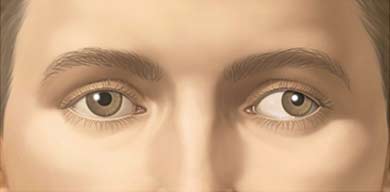Amblyopia – Lazy Eye
Description amblyopia
Amblyopia – disorder, is the weakening of vision in one eye. Amblyopia, often referred to as “lazy eye”, It is the most common in infants and children, but it can also occur in adults. Amblyopia is not contagious.
There are two common types of amblyopia:
- Anisometropic amblyopia there, when the power of vision in one eye differs from the other. It is necessary to consider the doctor, if he recommends the patient to wear glasses. One eye may suffer from myopia or hyperopia, the difference is particularly noticeable in the presence of astigmatism. People with amblyopia anisometropic disorder often asymptomatic;
- Strabismic amblyopia there, When there is a nekoaksial'nost' (misalignment) eye. There is the presence of strabismus.
If diagnosed in the early stages of the disease, amblyopia in most cases can be treated.

Causes of amblyopia
Amblyopia occurs, when the brain prefers image, comes only from one eye. This preference may weaken the vision in the eye, information on which is less used.
Apparent genetic or environmental factors, which can cause amblyopia exists.
Risk factors for amblyopia
Risk factors increase the probability of occurrence of amblyopia.
The following factors increase the risk of developing amblyopia. If you have any of these risk factors, tell your doctor:
- Age: Children nine years old and under:
- Crossed eyes;
- The big difference is in the power of the lens in the appointment of points (myopia, farsightedness or astigmatism);
- Lock view – Cataract, sagging eyelid or corneal scarring.
Symptoms of amblyopia
The symptoms for amblyopia vary from person to person. Some cases of amblyopia may be asymptomatic (without showing signs of frustration), Other proceed symptomatically (the presence of signs of frustration). If you experience the symptoms listed below, they are necessarily associated with amblyopia. In addition to amblyopia can be caused by other diseases. If you experience any of the symptoms, consult a doctor:
- Provisanie (inability to fully open) century, that blocks the pupil;
- Headache;
- Blurred vision;
- Excessive squinting or closing of the eyes;
- Closed eyes in bright sunlight;
- Misalignment (shift) one eye – usually, eye, which uses less, turns to his nose.
Diagnostics of amblyopia
The doctor will ask about your symptoms and medical history, and perform a physical examination. You may also be sent to an ophthalmologist – doctor, who specializes in treating diseases of the eye and measure eyesight. Since amblyopia tends to occur in young children, tests, which will appoint an ophthalmologist, will depend on the age of the patient and its ability to respond to the ophthalmologist. Tests may include the following:
- The study of visual acuity, eg, using a table for testing visual acuity;
- Testing cycloplegic refraction, which is held, to determine, as the perceived image of the eyeball, the projected lens of the eye. Used to run the test drops for dilation, allowing briefly paralyze the eye muscles, that control focus;
- Umbrascopy, which allows the eye doctor to determine the necessary power of the spectacle for the child;
- Using a prism to determine the degree of intersection between the eyes.
Treatment of amblyopia
First, the treatment should be carried diseases, preventing eyesight, such as cataracts. Besides, the doctor will treat significant deviations or visual defects, eg, excessive nearsightedness, farsightedness or astigmatism with glasses or contact lenses. This should lead to a decrease in the symptoms of amblyopia.
Treatment options also include the following:
Optical penalization using atropine
In a healthy eye ointment or drops nanostisya, containing atropine. It makes good eye out of focus and forces the patient to use the lazy eye.
Okklyuzionnaya childish amblyopia therapy
One type of treatment includes placing bandages on healthy eyes, that causes the patient to use the lazy eye.
Prevention of amblyopia
Although the way to prevent amblyopia does not exist, Regular eye exams can help identify the disorder at an early age. Children 3-5 years should be evaluated regularly. Children less 3 It should also be checked for the presence of vision problems. If your child does have amblyopia, the best result will be achieved, if treatment begins immediately after diagnosis.
